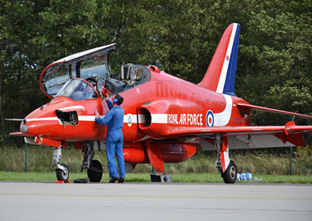
Plastics fall in
Arms and plastic
We all know that war often gives rise to inventions that revolutionise the world. Like it or not, that is a fact. But even in peacetime, the great nations’ armies press ahead, regardless, with research or at least help fund it on a large scale. What will tomorrow’s defence systems be? It is a safe bet that robots will be in there somewhere. And in fact, they already are – think of the recent headline-making drones. But they are only the visible tip of the iceberg. The army of the future has many surprises in store.

Drones: heavens above !

A drone is, of course, a stingless male bee. Not the unmanned aircraft that are becoming a growing part of the arsenal of the world’s most powerful armies. A drone is a sort of, armament’s jack-of-all-trades able to do surveillance, intelligence gathering, transport and combat. The advantages to armies that use it are clear: it is small, unobtrusive and does not endanger human life. Ideal, then? Not really, because ethical issues aside, they are unable to distinguish between civilian and military targets, for example; they cannot “think-on-the-go” to adapt to situational changes, making them more vulnerable than a human-piloted airplane. At present, though, these technology powerpacks are very costly, and the economies of scale from mass production, if possible, will not deliver big savings...One avenue being explored to reduce costs is that of new materials and polymers, naturally, have their rightful place .
3D printing: for drones too

It will come as no surprise to learn that many drones are designed using polymer fibre-based composite materials. Certainly, they get everyone’s vote for being lightweight, robust and fully mouldable...The problem though, is that they are still quite costly. And what drone manufacturers want, is to lower manufacturing costs. Many research centres are looking closely into the impressive capabilities of 3D printers – a technology even now delivering the goods since the first "specimen" 3D printed drones are fully flight-capable. Granted, they are still flimsy but engineers and printer manufacturers are trying to develop a new nylon-based polymer which would make the drone much more robust for no added weight. This new generation of near-disposable drones could deliver small equipment, do field reconnaissance or search for missing persons.
Better yet, a Spanish team has developed a new self-healing polymer - ideal should the drone get hit in mid-flight. The material consists of a flexible polyurethane network that relies on the metathesis reaction of aromatic disulfides - put simply, the atoms move spontaneously, seeking to bond together into a single structure. This chemical reaction is naturally able to create cross-links at room temperature, allowing the polymer to mend itself independently without an external power source.

Aircraft repairs in the midst of war zones

It will be a long time before we see fighter planes in the air made entirely from a 3D printer. The Airbus Group may be looking very closely into it, but it is not for anytime soon. Meanwhile, British aerospace company BAE Systems has achieved take-off for a model of its Tornado GR4 fighter plane with a 3D-printed air intake system, landing gear and cockpit radio protection elements. This is truly revolutionary, because the first tests are satisfactory and indicate that airplanes can fly just as well, when some hitherto metal parts are replaced by plastic. The main aim of this project is not to reduce the cost or weight of airplanes, but simply to avoid them being grounded when a part fails. This technology will enable army technicians in any war zone to make and replace the defective part in a few minutes to get the aircraft back in service. And the cost of such a part, around about a hundred euros, although not a main consideration, is a weighty argument in times of shrinking budgets...
Power-packed plastics

Drones don’t just rule the skies! What goes on in the briny deep tops the agenda of many admiralties. General Dynamics Electric Boat, the leading US manufacturer of submarines, is working with the U.S. Navy to develop a system for firing an underwater drone from a missile launch tube. The device could be launched from any combat submarine to unobtrusively support a wide range of missions from mine detection to reconnaissance and surveillance patrols.
Autonomy is being addressed by the development of a new type of battery: lithium-polymer batteries use a gelled electrolyte in place of a liquid electrolyte. The gel is more viscous than a liquid, and so does not slosh around, enabling the batteries to be made of lighter plastic materials. They can also be manufactured with more complex shapes, and so ultimately take up less space, by "slotting in the gaps" left by the other components. Finally, gel is far less volatile and flammable than liquid electrolyte, so damage to the battery will be less dangerous. Similarly, any metal impurities will no longer move between electrodes to create a short circuit.

Demining robots: plastic takes the hit

In military parlance, a mopping-up robot has nothing to do with industrial cleaning. It is, in fact, an autonomous mine-clearing device. So far, these robots have been heavy, cumbersome and particularly costly. That was before SCAMP (Specialized Compact Automated Mechanical-clearance Platform) came on the scene. This is an automated rolling cage containing six pistons which apply pressure to the ground. The pressure is precisely calculated to detonate a mine buried where the machine is bearing down. While the machine is normally able to withstand the blast of an anti-personnel mine, it has been designed in plastic and to be modular, so all parts are easily replaceable. And being plastic, the parts are particularly cheap. The idea for this robot came not from the military but the company Humanistic Robots looking for a simple way to save the lives of the hundreds of thousands of people living in some war-torn areas. The UN estimates that there are currently up to 100 million anti-personnel mines buried in the grounds of 85 countries.





